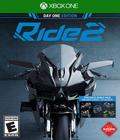Buy Ride 2
The original Ride was problematic because it looked and sounded like a previous-generation game. It expected expert-level handling due to an overly sensitive physics system, and the AI lacked the intelligence expected from a modern racer. The campaign required too much grinding before you reached the exciting bikes and tracks. The review of the first game suggested that gamers wait for the sequel to see if things got better, and with the arrival of Ride 2, we're about to see if that advice was sound.
The focus remains the same as before: Create a more modern take on Tourist Trophy. You have over 170 bikes from 20 different manufacturers, from superbikes and sport bikes to motocross versions. Aesthetically, you can't do much aside from switching between pre-made color sets, but you can tweak brakes, engines, etc., if you have the cash. You'll do this through 30 different tracks, each covering a variety of environment types and disciplines. It is a pretty big upgrade from the first game in this regard, and you'll realize later that the vehicle variety is put to good use.
Driving motorcycles is still very different from driving cars, unless you're playing with almost all of the modifiers and handicaps enabled. You had to manually tweak those things in the original game, but Ride 2 has many of them on by default; this makes a good first impression for beginners, since they can immediately jump in without being overwhelmed by the things they have to learn. Turn off the assists, and the game creeps into simulation territory, though only those with actual motorcycle riding experience will be able to tell for sure. Turning off assists also increases your credit payout for finishing a race, but the percentage increments are very small, so the benefits seem miniscule. The good news is that the physics system is less finicky, so it takes some effort for you to wipe out. The only exception is the walls, which still cause you to eat asphalt unless you're going at very, very low speeds.
New to the game is a rewind system, which lets you reverse time in case of a mishap, so you can retry a section of the race without having to start over. You can hit the rewind button at any time, and you can use it an infinite amount of times. You can rewind a very long stretch of time, approximately one-fourth of your lap for short tracks. You don't see that from other racing titles, but it is appreciated for those who may pass up on an earlier mistake until they see it affects them later in the race.
Before starting out with the game proper, you're given a race that acts as your racing mechanics tutorial. The idea behind this race is great, but the execution is a mess. There's a blurb about steering but nothing about the nuances of motorcycle racing versus four-wheeled vehicles. You learn which button initiates a rider lean but not the advantages of the lean. There's nothing about handbrakes or the rewind system, which should be highlighted considering how new it is. The race is only one lap on a short track, providing no time for the player to come to grips with the mechanics before having to do it on their own.
Get past this part, and you'll finally get to the game modes that are just as sparse as the previous title — at least on the surface. Quick Race allows you to race on any track configuration with any of the unlocked bikes. As in the prior offering, you can opt to race with locked bikes via a rental system, but those bikes won't earn you cash, so it's a better bet to use what you've got and gain more money.
Online play fares a little better this time around. The delay between the European and North American releases isn't as vast as before, so while the online community for the game is rather small, you have a better shot of finding a game than before. The skill difference is vast enough, however, that online play is only recommended if you've grasped more than the basic mechanics of motorcycle driving and have amassed a large garage of bikes. Online play is smooth on both good and bad connections, so it's rare to race against ghost players or see them warp.
World Tour mode is still the focus, but it has been more fleshed out. You start in the 301st position, and your goal is to reach the top of the world rankings, but there are now several sub-modes. The main one you'll pay attention to is Seasons, with each season comprised of eight races. You decide which races the season will consist of by selecting one of four categories. From there, you select the difficulty (amateur, beginner or expert) and have several different race events that are separated by bike type and ranking. The events also have different courses and race types, so while a majority are traditional races, you'll have a few that are drag races, skill courses and time trials.
The different bike events solves one of the big issues of the original Ride's World Tour, but you're not going to notice this immediately. The problem is that no matter which of the four starter bikes you choose, it's too slow for any of the eligible races. No matter which race you enter, you end up with the slowest bike while everyone else is armed with the best ones for that class. You might get lucky and not place last in an event, so you'll get a little bit of money, but that means lots of grinding to obtain something better to race with.
Then again, the available racing categories from the start means that the grinding isn't as severe as before. Get one of the top bikes in a lower class, and races become competitive. Top three finishes are a strong possibility, and it's easier to get cash and ranking upgrades. If you keep buying the top bike in each class, races are a breeze. Anything less means you'll struggle, since there doesn't seem to be a middle ground.
No matter how your races go, you're invited to Invitationals at the end of each season, special races that afford you loads of cash and a free bike (once you finish them). You can only participate in one per season, but the one you race in stays open as you progress. With 16 Invitationals to unlock and other event difficulties to unlock once gold medals are obtained, it feels like you're only scratching the surface. You only have the opportunity to compete in championships and head-to-head team events if you rank high enough and want to postpone your Season journey.
Aside from the opportunity to earn cash, all of the different modes are tied together by a Challenge system. There are three weekly and daily challenges, and completing any of them earns you cash or badges, the latter of which is traded for in-game bonuses, such as discounts on buying bikes from certain manufacturers or credits for finishing certain racing category events. If you don't care for those, you can use the badges to recruit better AI partners for your racing team.
All of the racing modes expose one flaw that hasn't been corrected: rider AI. There are hints that the AI has gotten a little better at acting normal, such as seeing them crash and respawn on the track. Those moments are fleeting, as they still run in the recommended racing line and don't move aside for obstacles. That means you'll get bumped by them if you have a slow bike or they'll clog up a corner if they converge around the same time.
The second issue that still plagues the title are the load times. Ride 2 fools you into thinking that load times are better, since the meters fill up at a decent clip. You'll notice that the load screens are spread out, and transitioning from one menu option to another brings up a loading screen. You'll also see consecutive short loading screens, so you'll see one finish and another begin. This ignores the long initial load to the main menu from the start screen, which is long enough to get in some decent mobile gaming before you have to pay attention to your console again.
Graphically, the game fares a little better than before. Frame rate is now at a solid 30fps, and the bikes retain the detailed look from before. Beyond this, Ride 2 still looks like it is shackled to previous-generation technology, even though there are no Xbox 360 and PS3 versions. Environments look bland due to the drab and muted color scheme. Lighting and shadows aren't as pronounced as you'd expect from this console generation, and rainy races only look impressive because water hits the camera lens although everything else appears unchanged.
On the sound front, the story remains the same. The soundtrack lacks excitement, but it generates forgettable noise to blend with the motorcycle engines you'll hear all the time. Those sounds are good, as there's certainly a difference that can be heard between each bike, depending on the engines. The rest of the effects are either muted, like faint crowd cheers, or absent, like crashes lacking impact sounds.
Ride 2 is certainly an improvement over the original game. There's still a grind to experience as you get through the World Tour, but it isn't as severe as before. The physics and general bike handling are balanced now, so both beginners and more experienced players can handle it, and the frame rate is more stable than before. With long loading times and an AI that hasn't evolved at all, it feels like the changes in Ride 2 aren't significant enough to attract people who weren't already enamored with the first game. Bike aficionados will certainly have more fun with the game, but if you really want to race something that's not on four wheels, try this out as a rental.
Score: 6.5/10
More articles about Ride 2










 Ride 2 is the new chapter in motorcycle simulation that features exciting game modes, new content, over 200 bikes to tame, an unprecedented level of customization and new race tracks to explore.
Ride 2 is the new chapter in motorcycle simulation that features exciting game modes, new content, over 200 bikes to tame, an unprecedented level of customization and new race tracks to explore.






